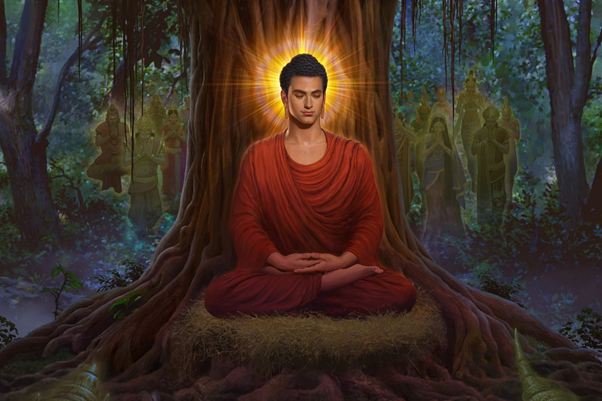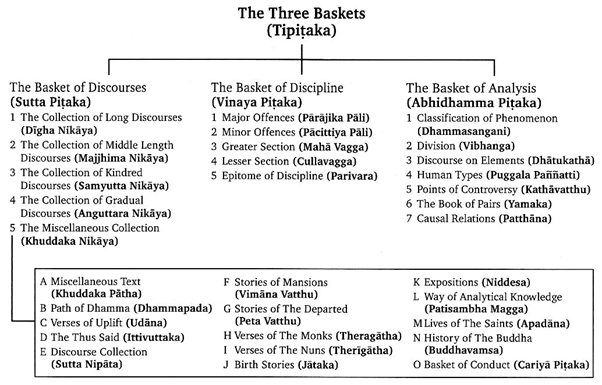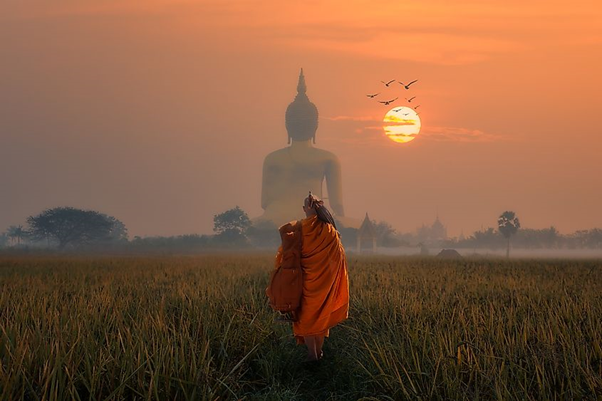Introduction
Buddhism is a religion in which teachings of the Lord Buddha is followed by the saints, nuns and lay people across the world. It is no new that it is one of the great ancient religions which emerged during the 5th and 6th C.E. Buddhism holds significance for India as it originated in the country. Since its rise as a religion to its decline it got such a massive response from common people who after following the path of Buddhism remained uncommon to others. The Mauryan Empire, the Kanishka Empire and many kingdoms of that time were influenced by the teachings of Buddha. This is evident from the art, literature, sculptures and extent of its spread about the popularity of the religion. So, why it was so important and popular is a question. Let us answer those in the below discussion.

Background
- Buddhism started in India over 2,600 years ago as a way of life that had a potential of transforming a person.
- The religion is based upon the teachings, life experiences of its founder Siddhartha Gautam, born in 563 BCE.
- He was born into royal family of Sakya clan who ruled from Kapilvastu, in Lumbiniwhich is situated near the Indo-Nepal Border.
- At the age of 29, Gautama left home and rejected his life of riches and embraced a lifestyle of asceticism,or extreme self-discipline.
- After 49 consecutive days of meditation, Gautama attained Bodhi (enlightenment)under a pipal tree at Bodhgaya a village in Bihar.
- Buddha gave his first sermon in the village of Sarnath,near the city of Benares in UP. This event is known as Dharma-Chakra-Pravartana (turning of the wheel of law).
- He died at the age of 80 in 483 BCE at a place called Kushinagaraa town in UP. The event is known as Mahaparinibban.
- Now it is one of the important religions of South and South-Eastern Asian
Teachings of Buddha
- Buddha asked his followers to avoid the two extremes of indulgence in worldly pleasure and the practice of strict abstinence and
- He ascribed instead the 'Madhyam Marg'or the middle path which was to be followed.
- According to him everyone was responsible for their own happiness in life, stressing upon the individualistic component of Buddhism.
- The main teachings of Buddhism are encapsulated in the basic concept of fournoble truths or ariya-sachchani and eightfold path or astangika marg.
- Four noble truths:
- Suffering (dukkha) is the essence of the world.
- Every suffering has a cause –
- Suffering could be extinguished –
- It can be achieved by following the Atthanga Magga (Eight Fold Path).
- Eight Fold Paths: The path consists of various interconnected activities related to knowledge, conduct, and meditative practices.
- Right view
- Right intention
- Right speech
- Right action
- Right livelihood
- Right mindfulness
- Right effort
- Right concentration
- The essence of Buddhism is the attainment of enlightenment. It points to a way of life that avoids self-indulgence and self-denial.
- There is no supreme god or deity in Buddhism.
- The ultimate goal of Buddha’s teaching was the attainment of nirvana which was not a place but an experience, and could be attained in this life.
- Buddha also established code of conduct both for the monastic order and the laymen to follow which are also known as the Five Precepts or Panchsheel and refrain from them.
-
- Violence
- stealing
- Sexual misconduct
- lying or gossip
- Taking intoxicating substances e.g. drugs or drinks.
Strengthening of Buddhism in India
- The early spread of Buddhism: In the sixth and fifth centuries B.C.E., economic development made the merchant class increasingly important. Merchants were attracted to Buddhist teachings, which contrasted with existing Brahmin religious practice.
- Buddhism became prominent in merchant communities and then spread throughout the Mauryan Empire through commercial connections and along trade routes. In this way, Buddhism also spread through the silk route into central Asia.
- Ashoka and the Mauryan Empire:
- The Mauryan Empire reached its peak at the time of emperor Ashoka, who converted to Buddhism after the Battle of Kalinga. This heralded a long period of stability under the Buddhist emperor.
- The power of the empire was vast—ambassadors were sent to other countries to propagate Buddhism.
- Stupas, pillars, and edicts on stone remain at Sanchi, Sarnath, and Mathura, indicating the extent of the empire was made at that time.
- Kushana Empire:
- The Kushan Empire under emperor Kani?ka ruled the strongly Buddhist region of Gandhara as well as other parts of northern India, Afghanistan and Pakistan.
- During this period, Gandharan Buddhism spread through the trade routes protected by the Kushans, out through the Khyber Pass into Central Asia.
Reasons for popularity of Buddhism
- Liberal & democratic – Unlike Brahmanism, it was far more liberal & democratic. It won the hearts of the lower class as it attacked the varna system. It welcomed people of all castes and even women were admitted to the Sangha. The people of Magadha readily accepted Buddhism as they were looked down upon by the orthodox Brahmanas.
- Simple language – The Buddha spread his message in the simple language of the masses. The Pali language which Buddha used was the spoken language of the masses. The Vedic religion was understood only with the help of Sanskrit language which was the monopoly of the Brahmins.
- The personality of the Buddha – The personality of the Buddha endeared him and his religion to the masses. He was kind and ego-less. His calm composure, sweet words of simple philosophy and his life of renunciation drew the masses to him. He had ready moral solutions for the problems of the people.
- Royal patronage – Royal patronage of Buddhism also accounted for its rapid rise. Kings like Prasenjit, Bimbisara, Ashoka, Kanishka patronised Buddhism and helped its spread throughout India and outside as well. Ashoka deputed his children to Sri Lanka for the spread of Buddhism.
- Inexpensive– Buddhism was inexpensive, without the expensive rituals that characterised the Vedic religion. It advocated a spiritual path without any material obligation of satisfying gods and Brahmins through gifts and rituals.
From where we get evidences for its rise
- Major Buddhist texts:
- The Buddha's teaching was oral. He taught for 45 years, adapting the teaching to suit the group (called Sangha) he was addressing.
- The Sangha memorized the teachings, and there were group recitations at festivals and special occasions.
- The teachings were rehearsed and authenticated at the First Council and were divided in Three Pitakas in 483 BC.
- His teachings were written down around 25 B.C.E. in Pali.
- Three Pitakas:
- The Vinaya Pitaka consists of rules of conduct and discipline applicable to the monastic life of the monks and nuns.
- The Sutta Pitaka consists of the main teaching or Dhamma of Buddha. It is divided into five Nikayas or collections:
- Digha Nikaya
- Majjhima Nikaya
- Samyutta Nikaya
- Anguttara Nikaya
- Khuddaka Nikaya
- The Abhidamma Pitaka is a philosophical analysis and systematization of the teaching and the scholarly activity of the monks.
- Other important Buddhist texts include Divyavadana, Dipavamsa, Mahavamsa, Milind Panho etc.

- Buddhist Councils:
- Buddhist Councils marked important turning points in the early Buddhism.
- These councils resulted in sectarian clashes and the eventual Great Schism that resulted in the two major schools, Theravada and Mahayana.
- In total, 4 major Buddhist councils were convened;
- First council: The council was held with the purpose of preserving Buddha’s teachings (Sutta) and rules for disciples. During this council, the teachings of Buddha were divided into three Pitakas.
- Second council: It was held in Vaishali,a village in Bihar under the patronage of the king Kalasoka in 383 BC. It was presided by Sabakami.
- Third council: It was held in 250 BC in Patliputraunder the patronage of Ashoka and was presided by Moggaliputta Tissa.
- Fourth council: Buddhism was divided into two sects namely Mahayana and Hinayana.
Different Schools of Buddhism emerged
- Mahayana: It is one of the two main schools of Buddhism.
- The term Mahayana is a Sanskrit word which literally means "Great Vehicle".
- It believes in the heavenliness of Buddha and Idol worship of Buddha and Bodhisattvas embodying Buddha Nature.
- It originated in northern India and Kashmir and then spread east into Central Asia, East Asia and some areas of Southeast Asia.
- Buddhist schools embedded in China, Korea, Tibet and Japan belong to the Mahayana tradition.
- Hinayana: Literally Lesser vehicle, also known as Abandoned Vehicle or Defective vehicle. It believes in the original teaching of Buddha or Doctrine of elders.
- It does not believe in Idol worship and tries to attain individual salvation through self-discipline and meditation.
- Theravada: It is the most ancient branch of extant Buddhism today.
- It remains closest to the original teachings of the Buddha.
- Theravada Buddhism developed in Sri Lanka and subsequently spread to the rest of Southeast Asia. It is the dominant form of religion in Cambodia, Laos, Myanmar, Sri Lanka, and Thailand.
- Vajrayana: Vajrayana means “The Vehicle of the Thunderbolt”, also known as tantric Buddhism.
- This Buddhist school developed in India around 900 CE.
- It is grounded on esoteric elements and very complex set of rituals compared with the rest of the Buddhist schools.
Decline of Buddhism in India
- Decline of Gupta Empire: The decline of Buddhism has been attributed to various factors, especially the regionalisation of India after the end of the Gupta Empire (320–650 CE).
- Foreign Invasions: Another factor was invasions of north India by various groups such as Indo-Iranian Huns, Hephthalites, Turkic-Mongolians, Arabs and Persians and subsequent destruction of Buddhist institutions such as Nalanda and religious persecutions.
- Destroying Relics and literature related to Buddhism: Islamization of Bengal and demolitions of Nalanda, Vikramasila and Odantapuri by Muhammad bin Bakhtiyar Khalji have severely weakened the practice of Buddhism in East India where it previously received strong patronisation under the Pala Empire.

Contribution of Buddhism in Indian Culture
- Buddhism has made remarkable contribution to the development of Indian culture:
- The concept of ahimsa was its chief contribution. Later, it became one of the cherished values of our nation.
- Its contribution to the art and architecture of India was notable. The stupas at Sanchi, Bharhut and Gaya are wonderful pieces of architecture.
- It promoted education through residential universities like those at Taxila, Nalanda and Vikramasila.
- The language of Pali and other local languages developed through the teachings of Buddhism.
- It had also promoted the spread of Indian culture to other parts of Asia.
Conclusion
Buddhism tried to mitigate the evils resulting from the new material life of the sixth century BCE. Since the Buddhists had a keen awareness of the problems (social & economic disparities), they presented innovative solutions to these concerns. Buddhism asked people NOT to accumulate wealth, indulge in cruelty or violence.
Today the total Buddhist population as per 2010 census in the Indian subcontinent is about 10 million, of which about 7.2% lived in Bangladesh, 92.5% in India and 0.2% in Pakistan. This shows the importance of this religion in cultural extent and its reach to the whole of Asia and majorly in South-central Asia. Buddhism is not just a religion but a way of life to attain a selfless, peaceful and Soulful life. India (in present time) is using it as soft power diplomacy with south Asian and other countries. It makes a link between India and the World.


